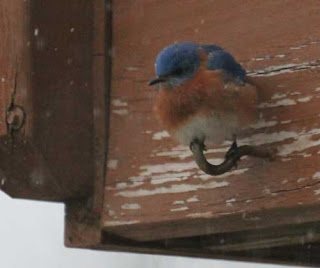It has not felt like spring the last couple of days. Sunday and Monday morning the temperatures were 17°F and 18°F, respectively. It was a balmy 29°F today. The good news is that it has been sunny for several days, which is always good for my mood. We are supposed to have another 1.5” of rain tomorrow, although we often see that number decrease significantly before anything falls from the sky.
At 11:00 yesterday morning, Terry called me. “Today is
perfect for burning the wet meadow. I need to do it before the wind changed.”
I had just finished exercising and was about to step into
the shower, but I got dressed again and went out to watch and/or help as
needed.
“This won’t take long,” Terry said.
He was right. He started lighting the fire at 11:06. This picture was taken at 11:08.
 |
| Starting the burn |
The wet meadow is, at present, a failed restoration. It looked good for a couple of years, but one year it flooded for a long time, and I couldn’t get in to do anything about the reed canary grass. Now it is mostly reed canary grass. The only native that has been able to compete is a tall aster that I have never been able to identify. As the burn progressed, the aster stems make little chimneys of smoke. They must be hollow.
 |
| Smoke coming out a "chimney" of a hollow aster stem |
At 11:15, the meadow was already half burned. The burn coverage was good. The fire only went around two small spots.
 |
| A line of fire 8 minutes into the burn |
Terry will mow the area a couple of times. Perhaps this year
I can do something to beat back the reed canary grass.
We keep increasing the number of migrants we see at the bird feeders. Our favorites aren’t back yet. The red-winged blackbirds have been moving through for awhile, but some are now settling in and chasing the smaller birds from the feeders. Hilda used to get so mad at them! But a bird’s gonna do what a bird’s gonna do. Also in this picture is the first brown-headed cowbird I’ve seen. Hilda didn’t like them either, as they are nest parasites. I’m sure I’ve mentioned before that I used to think that was a pretty low-down thing to do until I learned that it was an adaptation to a mobile life. Cowbirds follow herds of larger grazing animals, probably bison originally, and they can’t be tied down to a nest.
 |
| Brown-headed cowbird (left) with a red-winged blackbird |
Grackles are back too. Its head has a pretty iridescence. I suppose it gets the bad rap from its harsh call and tendency to travel in large flocks. Like blackbirds, they can probably do considerable damage to a field of corn.
 |
| Grackle |
I do not have to use my imagination to see that the gold finches are turning yellow. This one is ahead of the curve. I bet he gets the best girls.
 |
| A goldfinch gets his breeding colors |
Oh, those turkeys. We had a big tom displaying to four hens last Thursday.
 |
| Four turkey hens, left, one tom, right |
The tom never got much closer to the hens. Once he was all puffed up, he couldn’t move fast. He strutted slowly toward the girls, and they walked away at a much faster pace. He dropped his tail, folded up his wings, and tried to catch up. But as soon as he started displaying again, off they went. Dude! Too early to be laying eggs!
 |
| Hey baby! Hey baby! |
He finally gave up. Here he is, looking dejected. Poor Tom.
 |
| Where did everybody go? |
















































